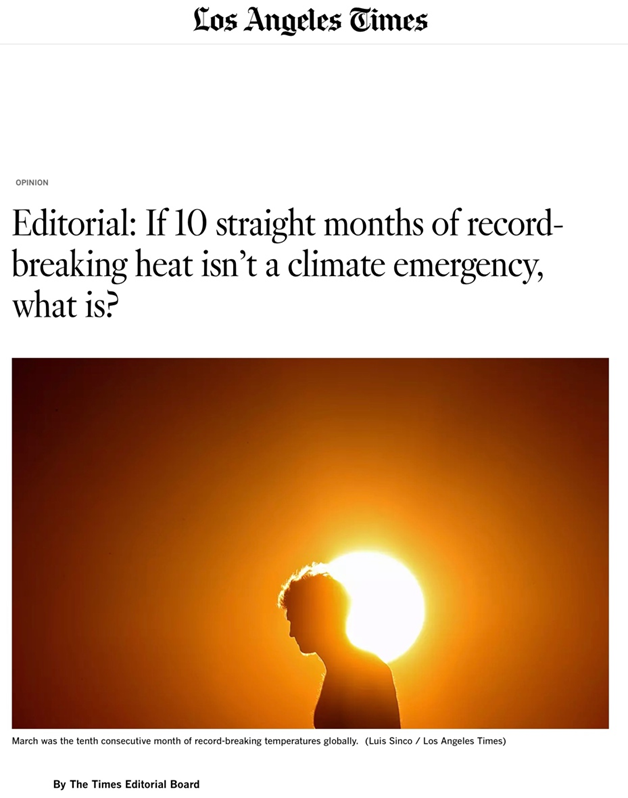By Paul Homewood
There is not the slightest doubt that the US winter of 2013/14 was exceptionally cold by any standards, as the BBC reported at the time:
http://www.bbc.co.uk/news/world-us-canada-25647963
The cold weather really began on Jan 2nd, when an Arctic front descended across much of the country, and extended well into March.
The NWS wrote at the end of the winter:
The winter of 2013-14 finished as one of the coldest winters in recent memory for New York State. Snowfall across Western and North Central New York was above normal for many areas, and in some locations well above normal. This winter comes on the heels of two previous mild winters, making the cold and snow this winter feel that much harsher.
Temperatures this winter finished below normal every month, and the January through March timeframe finished at least 4 degrees below normal for the two primary climate stations of Western New York (Buffalo and Rochester)…..
Relentless cold continued through the month of January across the region
http://www.weather.gov/buf/wintersummary1314
However, when we look at NOAA’s official temperature record for New York State in January, 2014 only ranks as 30th coldest since 1895, with a mean temperature of 16.9F.
So I thought I would do some digging into the actual temperature data, to see if NOAA’s version stacks up. I promise that you will be astounded at the results!
New York State is subdivided into 10 sub-divisions, and I have taken a close look at one, Central Lakes (Div 10).
The NOAA graph shows a similar picture as the Statewide one, with a mean temperature of 17.8F, ranking 24th coldest.
Since 1889, monthly state climatological reports have been archived, originally by the Dept of Agriculture, and now by NOAA.
I have decided to compare Jan 2014 data, with the same month in 1943. According to NOAA, the latter was not dissimilar, with a mean of 18.7F, and a rank of 28th, for Division 10. In other words it was 0.9F warmer than 2014.
Below is the report for January 1943. I have given all of the PDF links, but the State reports can also all be accessed here.
Let’s focus in more closely on that mean temperature column, all in Fahrenheit of course:
And here is the monthly report for Jan 2014:
Some old stations have dropped out over the years, and new ones taken on. But when we check the 2014 report we find that seven stations are still going. Below is the comparison between 1943 and 2014:
| Mean Temperature F | |||
| 1943 | 2014 | Diff | |
| Auburn | 22.2 | 18.5 | -3.7 |
| Avon | 21.7 | 19.3 | -2.4 |
| Dansville | 24.1 | 19.8 | -4.3 |
| Geneva | 22.3 | 18.1 | -4.2 |
| Hemlock | 21.0 | 19.0 | -2.0 |
| Ithaca | 20.6 | 17.7 | -2.9 |
| Syracuse AP | 19.2 | 19.9 | 0.7 |
| Average | 21.6 | 18.9 | -2.7 |
| Average excl | |||
| Syracuse AP | 22.0 | 18.7 | -3.3 |
| NOAA | 18.7 | 17.8 | -0.9 |
On average the mean temperatures in Jan 2014 were 2.7F less than in 1943. Yet, according to NOAA, the difference was only 0.9F.
Somehow, NOAA has adjusted past temperatures down, relatively, by 1.8F.
Indeed, it is arguably worse than that. You will notice that there is an outlier in Syracuse, which suggests that 2014, quite nonsensically, was warmer. Syracuse’s temperature station is, however, based at the International Airport there, slap bang in between runways. (The blue marker is the current site).
https://www.ncdc.noaa.gov/homr/#ncdcstnid=10008542&tab=LOCATIONS
The weather station has been at the same location, to within a few hundred yards, since 1929, when it looked like this. During the war it was used as a flight training centre.

http://www.syrairport.org/about-us/history/
Now it is an international airport, with two asphalt runways handling nearly 2 million passenger a year.

Clearly, given the divergence in temperatures between Syracuse and the other six divisional sites, there is a massive UHI effect here. If we exclude Syracuse, which clearly should not be used for climate purposes, the average difference between 1943 and 2014 rises to 3.3F.
This means that NOAA has adjusted temperatures by an astonishing 2.4F.
Of the seven sites, six have remained at the same locations, within a few yards. The station at Auburn has moved by a couple of miles, but is still in similar terrain.
There is no reason then why any major adjustments should have been required at any site.
Apologists for temperature tampering usually say it is all due to TOBS (Time of Observation). Yet the station at Ithaca, based at Cornell University, has used morning readings throughout. With a temperature difference of 2.9C, this is typical of the other sites, suggesting that any bias from TOBS is minor.
I have checked out some of the other divisions, and these come up with similarly large discrepancies. I will post detail tomorrow, as this is already getting a data heavy post.
I have also looked at the annual data, and this gives similar results to January. Again I will post up tomorrow, along with a very significant analysis of the Syracuse numbers.
The impact of these adjustments is simply staggering. If Jan 2014’s temperatures are reduced back down by 3.3F, they become 14.5F. This would make the month the 9th coldest on record in Central Lakes, ranked between 1940 and 1981.
This would certainly correlate with the NWS report, mentioned above, which stated:
The winter of 2013-14 was one of the coldest and snowiest in decades across Western and North Central New York.
These wholesale changes cannot be explained away changes to individual stations. It may be that homogenisation procedures, infilling of missing data and urban heat islands have contributed.
Under the new nClimDiv system, introduced in 2014, NOAA’s methodology is extremely opaque. They don’t, to the best of my knowledge, publish the data and adjustments used.
In essence, we are asked to accept NOAA’s version without being able to check or verify it.
Whatever the reason for the adjustments, the climate record for New York State has been changed out of all recognition, and bears no resemblance to the actual official data.












